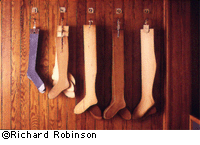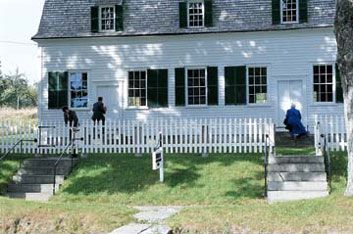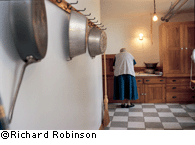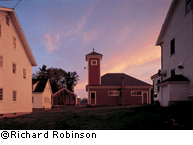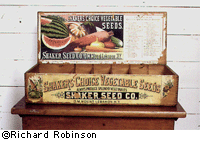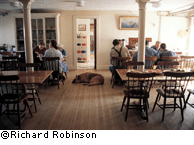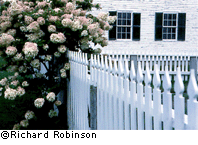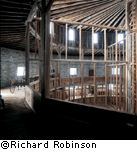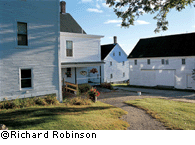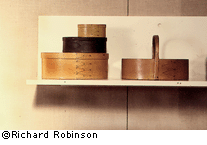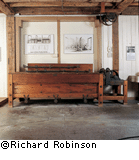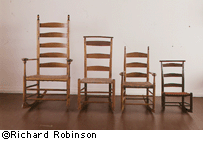Living a Tradition
At a handful of sites scattered across New England, Shaker communities transport the past into the present
/https://tf-cmsv2-smithsonianmag-media.s3.amazonaws.com/filer/journeys_feature_388.jpg)
We must, according to tradition, use separate doors: women enter on the right, men on the left. We must take no notes. Also, no laptop computer. No tape recorder. Brother Arnold Hadd explains: this is Sunday morning meeting—no worldly work. But are we welcome? "Yea," says Brother Arnold, employing his antiquated form of address. He is in his 40s, slight, intense, dark-bearded. "All are welcome."
We watch the four brothers—black trousers, white shirts, black vests—file inside. A few visiting men follow them in, the "world's people." Four sisters go through the scrupulously matching door on the right, wearing dark gowns, bodices modestly wrapped in hooded cloaks. Visiting women follow them into the white-clapboard meetinghouse, unchanged since 1794, except that now SUVs and tractor-trailers roar by on Maine Route 26.
We count 18 buildings here at Sabbathday Lake. But at its zenith, in the 1800s, this community of the United Society of Believers in Christ's Second Appearing—the Shakers—stretched a mile along this road. Once, a score of Shaker communities, prosperous and neat, the envy of their neighbors, dotted the farmlands from Maine down through New Hampshire, Massachusetts, Connecticut and New York, westward to Ohio, Indiana and Kentucky, and south as far as White Oak, Georgia, and Narcoosee, Florida. Now many are torn down or taken over by the world's people for schools or jails or Shaker museums. Only here at Sabbathday Lake, in New Gloucester, Maine, do the world's last eight Shakers keep the old ways.
But we—who came here knowing nothing about Shakers except that they made stunning furniture—are surprised at what we are learning about those old ways. In their heyday, we have discovered, Shakers were business go-getters and technologists. They invented prolifically, and they were aficionados of all that was new and useful, from snapshot cameras to linoleum. Celibates, communists, they lived apart from ordinary society. Yet, in other ways, they were quintessentially American.
"That they may see your good works"
Inside the meetinghouse, we sit on plain Shaker benches, men facing women. There is no altar. No minister. No statues. No stained-glass windows. There is a single bowl of perfect sunflowers. Walls are white, woodwork blue, the colors of light and sky, signifying heaven. It is the original blue paint, made from sage blossoms, indigo and blueberry skins, mixed in milk. Sister Frances Carr reads commandingly from the Bible selection for the day, Matthew 5:16: "Let your light so shine before men, that they may see your good works."
She herself is a Shaker good work, for she was raised a "Shaker girl." But she was not born a Shaker. Nobody was.
Shaker founder Ann Lee, a blacksmith's daughter born in 1736, in Manchester, England, an illiterate velvet cutter, said her followers must be celibate. Historians speculate it was because her parents—alarmed when she joined the "Shaking Quakers," an ecstatic fringe sect—arranged her 1762 marriage to a blacksmith. Each of Ann's four children died in infancy. Historian Edward Deming Andrews noted in his 1953 account, The People Called Shakers, that she saw those deaths as a judgment upon her for "concupiscence." Andrews quotes her saying she began to avoid her bed "as if it had been made of embers." She shunned sleep, eating and drinking only what was "mean and poor," that her soul "might hunger for nothing but God."
Celibate, the Shakers were childless. But they took in orphans. "In the 19th century, when there was no Aid to Families with Dependent Children or Social Security, it was impossible for most single parents to raise a family, and—if no relatives were available—they often would look to the Shakers," Sister Frances Carr had told us. She herself came to the Shakers 63 years ago, when she was 10 years old, along with her younger sister, preceded by several older siblings. Sabbathday Lake took in orphans until the 1960s, when the Shakers finally were too few to care for children.
"Nobody expected I'd ever become a Shaker"
"I was defiant," Sister Frances told us. "I did not want to be here, and I did not care for the sister in charge of us. I was also a bit of a ringleader, to make things exciting, so all through my teens nobody expected I'd ever become a Shaker." Shakers, she explained, raised their Shaker boys and Shaker girls with little pressure to join the sect. When the children reached adulthood, they decided whether to go out into the world, and most did. As Shaker children, they had learned at least one trade. Upon leaving, they received clothes, perhaps tools, a little money. They were always welcome to return. "I thought God had called me to this work," Sister Frances told us.
Today's meeting—Bible readings, thoughts from each Shaker—focuses on fostering world peace by creating peace within yourself, pacifism being a core Shaker doctrine. We "amen" each reading and testimony with an appropriate hymn. "There are about 10,000 Shaker songs in existence, and this community's present repertoire is 400 to 500 songs," Sister Frances had told us, noting that the Sabbathday Lake Shakers have recorded two CDs, Simple Gifts (1994) and The Golden Harvest (2000), with the Boston Camerata.
Originally, at meetings like this, Shakers danced, "shook." Elders withdrew the "gift" of dance around 1900, when few brothers remained. But the Shakers' early wild dancing unnerved nonbelievers. So did their predilection for disrupting mainstream church services with shouts of "Hypocrisy!" Persecuted, jailed, scorned, in 1774 Mother Ann Lee, as she was known, and seven followers sailed to New York City. They did menial work. Eventually, from a Dutch patroon, they leased a swath of woods and swamp near Albany, in Niskeyuna, also called Watervliet, to start building heaven on earth.
God is both male and female
Ann Lee and her followers crisscrossed Massachusetts and Connecticut, reaping converts, but also making enemies. One offense was rejecting the Trinity. God, they said, is a duality: male and female. Thus, men and women must be equal. Shakers, like Jesus, must be celibate. Also, Jesus owned nothing. And so Shakers must sign over their property to the community, to be owned in common. Shakers were communists.
During the Revolutionary War, rumors circulated that the immigrants from Manchester were British spies. After assaults and imprisonment, Ann Lee died on September 8, 1784. Her death brought Shakerdom alive. Her successor, one of her British followers, built a meetinghouse at New Lebanon. This settlement, later called Mount Lebanon, on New York's border with Massachusetts, became the headquarters, or "Central Ministry."
At Sabbathday Lake we are invited to the Shakers' Monday noon meal, in the community's six-story brick dwelling house. It is a bit like a dormitory, a lot like an old farmhouse. At 11:50 A.M. the building's Great Bell summons the Shakers from their work in the barns and offices. We assemble in separate men's and women's waiting rooms to idly talk for ten minutes.
"Mother Ann quoted Jesus about rendering unto Caesar what is Caesar's, so Shaker communities have always paid taxes, although as religious places, they could have avoided them," Brother Arnold notes. "I can't say we've ever done it joyfully, but we've always done it—recently our tax doubled; when Sister Frances opened the bill, I could hear her from the other end of the house."
At noon a buzzer summons us into the dining room. One table for women, one for men. Most of the food we are served came from here: ham, cauliflower, tomatoes, cucumbers, bread, a fruit compote of cantaloupe, honeydew melon and raspberries. Meals, like work, are worship. But rules have relaxed. Conversation murmurs.
Brother Arnold oversees the vegetable garden. "We don't grow potatoes anymore because there is no way to beat the Colorado potato beetles," he says. "We farm organically—it would be simpler and easier to just go out and buy food, but our own is the freshest and best."
When Arnold was 16, in Massachusetts, raised a Methodist, he wrote to this community with a historical question. "I was so impressed with the response that I started corresponding," he says. In high school, he was unsure what he wanted to become—an anthropologist? Archaeologist? Chef? He decided, at the age of 21, to become a Shaker.
Sister Frances wrote Shaker Your Plate: Of Shaker Cooks and Cooking, and she rules the kitchen. Brother Wayne Smith, who is tall and strapping and looks vaguely like a young Garrison Keillor, tends the community's 50 sheep. "We raise the sheep for their wool, to supply our shop with yarn," he says. "They're working lawn ornaments." He also tends two steers, Malachi and Amos. "We'll eat them sooner or later," he predicts.
He grew up in South Portland, Maine, nominally a Baptist. "I went to church at gunpoint, usually," he says. But a Shaker brother was teaching Latin at his school, earning extra income for Sabbathday Lake. "I actually opened my Latin book and studied," Brother Wayne says. He began visiting Sabbathday Lake at age 14, discovering a "gift" for working with animals. He, too, decided to join, at the age of 17.
Shaker industries have dwindled away
Besides farming, the community supports itself as Shakers always have: with this and that. For instance, the Shakers turned unused buildings into a museum. Now 6,000 visitors each year tour this isolated Maine community located north of Portland and south of Lewiston and Auburn.
"I'm the printer, and we earn a little selling our publications, and also our jams and jellies and pickles and yarns," Brother Arnold says. They market herbs as well. But many Shaker industries have dwindled away. "Our great mill used to turn out shingles and cider on the first level, and the second level was a machine shop, and the attic had a carding mill; we had a sawmill and cooper's shop, in addition," Brother Arnold says. And Sister Frances adds: "It was built in 1853 and operated until 1941, when all the hired people went off to war. Now its granite foundations make for a magnificent ruin!" But the community maintains a tree farm and gravel pits, and it leases out its lakeshore lands. The Shakers lease out their orchards, too, but they still keep some apples, Cortlands and McIntoshes, to sell.
"We're not a wealthy community, by any means, but there are many causes we contribute to—for a long time we've been particularly concerned with hunger in the world," Sister Frances tells us. Brother Arnold lectures across the United States and overseas. "It's just to tell people what we believe and how we live, and that we're alive."
A work ethic which might be called "anthillism"
We are asked back for supper, the day's lightest meal. Dispensing with old ways, the genders sup together. Afterward, as it grows dark, we sit talking on a porch with the brothers and sisters and an ebullient Baptist minister from Mississippi, an old friend of the Shakers. Watching the moon rise, we find ourselves recounting our first encounter with Shakerism, a few weeks ago, during a visit to the Shaker village in Canterbury, New Hampshire, now a museum.
We had been invited to stay in Canterbury's brick trustees' building. Such roadside structures served as offices where a few designated Shaker trustees met the world's people to buy and sell and arrange shipment of Shaker products. Our room featured the built-in cabinets and drawers that Shakers favored, for efficiency. Through our windows we could see the village, atop a hillside meadow. Meetinghouse, dwelling house, shops, sheds—they seemed to embody the Shakers' best-known song, Simple Gifts. But they also expressed another Shaker trait, an all-consuming work ethic which might be called "anthillism."
In the early 1800s Joseph Meacham, who had assumed leadership, regimented Shaker communities down to meals. They must be finished quickly, the food consumed in silence. Canterbury's president, historian Scott Swank, told us such rules expressed a perfectionist impulse. "Renovating our 1793 dwelling house, we've found that even details hidden in walls, where nobody could see them, were of superior construction," he said. "For instance, ceilings hid beams, but the Shakers still planed beams smooth."
Buildings were color-coded. "Meetinghouses were white, dwelling houses were French yellow, work buildings a darker yellow, agricultural buildings were unpainted or red, and they painted their roofs red, so there were a lot of yellow buildings with red roofs," Swank told us. "They also color-coded interiors—Prussian blue in meetinghouses, red for working areas, yellow for shops and dwelling houses." Canterbury painted its sisters' workshop brilliant orange yellow, with vermilion trim, maybe to offset the New England winter's gloom.
Everyone, they believed, is equal
"This was a work-oriented community," Swank told us. "They expressed themselves in activity, worshipping by dancing and singing, rather than sitting down and listening to a sermon, for instance, and they were somewhat anti-intellectual in their early years, and they were highly regulated," he said. Shakers had a deeply humane side, too, accepting into their communities former slaves, Jews, Catholics—everyone, they believed, is equal.
Nor did a Shaker bonnet and cloak transform you into an emotionless worker ant. In Canterbury's newly restored dwelling house, we met Alberta MacMillan Kirkpatrick, tall, white-haired, smiling, seated on a Shaker rocker in the room where she was raised, back for a visit. "Sister Betsy lived in the next room, when I was 11; she had a bad kidney problem and didn't walk well," she told us. "So I'd tap on her door to see if she'd like me to visit and she'd tell me stories." On her 7th birthday, Kirkpatrick, from Boston, saw her mother buried. Her father gave her to a succession of six unpleasant foster families, the final one abusive. In 1929 he telephoned Canterbury, asking the Shakers to take his daughter. They said they were not taking anymore children.
"One sister, Marguerite, was going to receive nothing for Christmas because each sister was supposed to list three possible gifts she'd like, and Marguerite, who was about 40, had written—1. a little girl, 2. a little girl, and 3. a little girl," Kirkpatrick told us. She became Sister Marguerite's Christmas present.
There was plenty of time for play
"We drove up on December 19 in my father's old Buick, with no heater, and it was snowy and icy," she remembers. Sister Marguerite erupted out of a door in the village and ran down the walk, her Shaker cloak flying in the wind. Marguerite dropped to her knees in front of the child. "She hugged me, saying, ‘Oh, Bertie, I thought you'd never arrive!'"
Kirkpatrick told us: "Every morning I'd get up and look out these windows and I couldn't wait to start the day, because I was so free." She attended a school taught by Sister Marguerite. There was plenty of time for play. Helped by the sisters, the ten Shaker girls put on plays. "And we celebrated every holiday, putting up a maypole and dancing around it, July Fourth, Memorial Day," Kirkpatrick told us. "On Halloween we took over the laundry, and one year Sister Marguerite got an old gray cape and made a face on it, and held it up on a mop stick so she looked 12 feet tall."
Shaker dancing took on a new meaning: "Sister Aida taught us to fox-trot and waltz and do the two-step." Kirkpatrick drew headshakes for stilt-walking and vaulting down the stairs. But, as disciplinarians, Shakers were softies. "They were so lenient—I climbed into the bell tower, which we weren't supposed to do, and the only discipline was, ‘Bertie, please don't do that again,'" Kirkpatrick said. After she graduated at age 16, Kirkpatrick began real work in the community, rising at 5:00 every morning to help bake apple and mince pies, along with eggs, bacon and home fries for breakfast. She shoveled snow and swept floors. She left at age 18, but returned every year for Marguerite's birthday.
"We've dug up stuff you wouldn't expect"
Later, behind the trustees' building, we talked with archaeologist David Starbuck, who has been excavating at Canterbury since 1978, when he was a professor at Boston University. Today, as he probed the remains of a blacksmith's shop, he told us what his excavations have revealed.
"People want Shakers to be a certain way, but they had strict periods and relaxed periods," he told us. "We've dug up stuff you wouldn't expect, like tobacco pipes, beer and whiskey bottles, perfume bottles, hair restorers, and combs—they seemed really concerned about their appearance." Shakers have proved much like the rest of us.
It's important, too, to remember the altruism that underlay the Shaker sense of community. Canterbury's curator, Sheryl Hack, had told us that during the 1800s, when social services were meager at best, it was not solely religious fervor that brought converts. A sick farmer, unable to plow or milk, might face disaster, but as a Shaker he had a community to back him up. Women then had scant options for work, and might be forced to marry for financial security—becoming a Shaker could be attractive. But after the Civil War, as society's options increased, ever fewer men joined. Sisters had to hire outside help. Eventually, women, too, their options broadening, stopped converting. By 1960, only Canterbury and Sabbathday Lake remained viable.
During the 1960s, the Shakers feared that an influx of counterculture people, drawn to communal living—but not religion—would distort Shakerism or even usurp the community's resources. So, at Canterbury, where the last brother had died, they decided to pull the plug, thereby ending their tradition. But Sabbathday Lake defiantly kept taking in converts, like Arnold Hadd and Wayne Smith. Un-Shakerlike bitterness flared between the two communities.
It looks like a UFO
Above all, Starbuck explains, Shakers were quintessentially American: efficiency addicts and prolific inventors, with a business knack. To learn more, we visited Hancock Shaker Village, in Pittsfield, Massachusetts. In 1948 the Central Ministry moved from Mount Lebanon to Hancock. In 1960 it moved to Canterbury. Hancock became a museum, teaching the world about Shakers.
We particularly wanted to see Hancock's huge, gray-stone barn, which is round. "In 1826 the Shakers here had one of New England's largest dairy herds, about 200 head, when most of their neighbors had a herd of, maybe, 3," Cloud Kennedy, a Hancock historical interpreter, told us as we gazed at the barn, which looks like a stone UFO mother ship. Improbably woolly merino sheep wandered by. "The Shakers were among the first to import them, around 1831," Kennedy said. She noted that Hancock, in its heyday, had 60 buildings and 4,000 acres, while nearby Mount Lebanon had 6,000 acres. "The size of that, and this much weirdness and this much prosperity, terrified the people around them, so there was harassment and there was arson," she said.
This round barn replaced an older barn that burned. By way of ramps, cows or horses walked directly into either of the barn's lower two levels. Walking inside ourselves, we almost gasped. Stanchions circle a vast open core. Far overhead, at the building's apex, a cupola acts as a vent. Rafters radiate from the cupola to support the round roof. Sunbeams illuminate an intricate array of vertical masts supporting the floors, the rafters, the roof. "They built their houses like barns and their barns like cathedrals," Cloud Kennedy said.
But this cathedral was practical. Kennedy described the brothers bringing in their herd for the morning milking. Each cow, unsupervised, walks around the outer circle to its own stanchion and pokes its head through, attracted by the core's 400 tons of hay, tossed down from above. "Because the barn is round, the cows' heads are closer together than their rears, making more room for milking," Kennedy told us. "Meanwhile, the brothers can chuck the manure down to a manure pit, for spreading onto the fields." She added: "The brothers can milk all the cows and be done before breakfast."
Shakers embraced time-saving technology
Shakers embraced technology because it saved time, which was God's. Also, it saved their own energy, for worship. Brooms of the 1700s were merely bundled twigs tied to a stick. Shakers invented the more efficient flat broom we use today. They invented washing machines with powered agitators, and adjustable water temperatures and soap concentrations, selling them to hotels nationwide. They were the first to package and sell seeds. They also came up with a rotary harrow, wrinkle-resistant fabric, a pea sheller, a revolving oven, a machine for coring and quartering apples. Shakers embraced innovations from the world too. They were among the earliest photography bugs. Usually, they were their localities' earliest to get in electricity and buy automobiles.
Machines and architecture were not the sole Shaker "gifts." Hancock exhibits a major collection of Shaker "gift drawings," which came to brothers and sisters in trances or moments of inspiration. Probably the most famous is The Tree of Life. It is a stunning green-leafed tree, displaying intensely green and orange fruits. Shakers also had a "gift" for chairs and tables. We next visited the Shaker Museum and Library, in Old Chatham, New York, a leading collection of Shaker artifacts. Curator Starlyn D'Angelo showed us examples of the elegantly simple Shaker chairs that inspired Danish modern furniture. By the 1870s, Mount Lebanon's chair factory was selling these chairs nationwide through an illustrated mail-order catalog.
Mother Ann is buried just a short walk from Albany's airport
Furniture made by Shaker hands sells for many thousands of dollars today. But craftsman Christian Becksvoort, in The Shaker Legacy, quotes Sister Mildred Barker, who died at Sabbathday Lake in 1990, at age 92: "I would like to be remembered as one who had pledged myself to the service of God and had fulfilled that pledge as perfectly as I can—not as a piece of furniture."
We ended our travels at America's first Shaker settlement, in Watervliet, New York, where Mother Ann died. Hank Williams, a former New York State commissioner of environmental conservation, now director of the Shaker Heritage Society, drove us to the Shakers' small, fenced-in graveyard. It is only a short walk from Albany's airport, and jetliners roar overhead. Here 445 Shakers lie as regimented as in life, headstones arranged in phalanxes. "Can you pick out Mother Ann's grave?" Williams asked. It is in the center of the sixth row, thigh-high rather than just knee-high, like the other stones. It is inscribed: "Mother Ann Lee Born in Manchester, England. Feb. 29, 1736. Died in Watervliet N.Y. Sept. 8, 1784." Williams pointed to the top of her tombstone, lined with pennies and quarters. "We don't know who leaves coins," he said. "It's an amazing thing."
